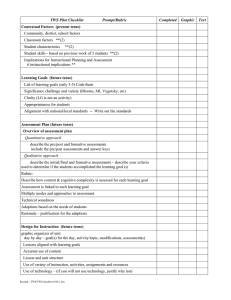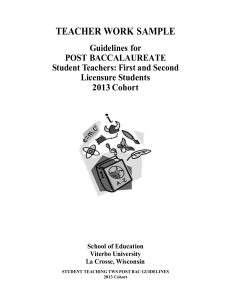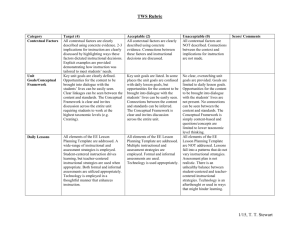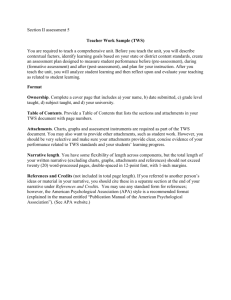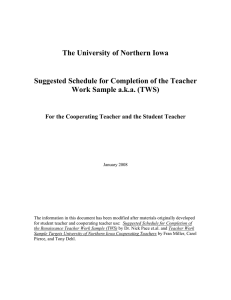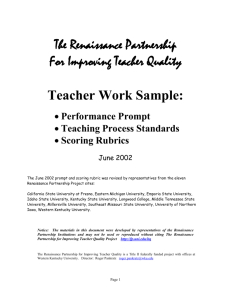Learning Goals
advertisement
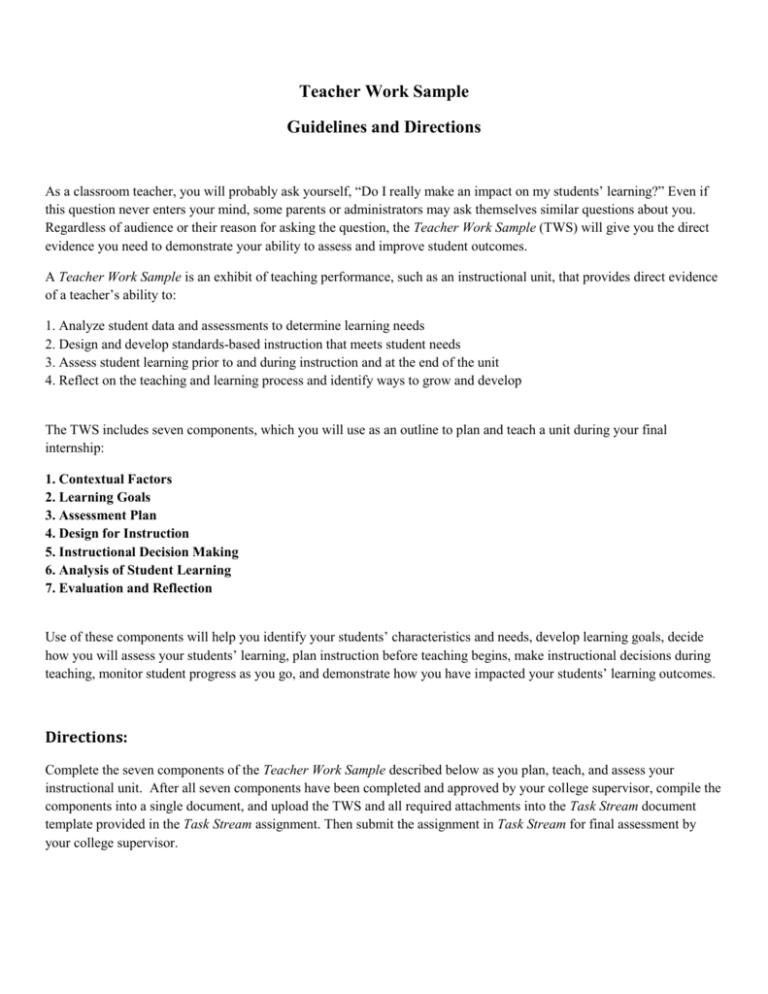
Teacher Work Sample Guidelines and Directions As a classroom teacher, you will probably ask yourself, “Do I really make an impact on my students’ learning?” Even if this question never enters your mind, some parents or administrators may ask themselves similar questions about you. Regardless of audience or their reason for asking the question, the Teacher Work Sample (TWS) will give you the direct evidence you need to demonstrate your ability to assess and improve student outcomes. A Teacher Work Sample is an exhibit of teaching performance, such as an instructional unit, that provides direct evidence of a teacher’s ability to: 1. Analyze student data and assessments to determine learning needs 2. Design and develop standards-based instruction that meets student needs 3. Assess student learning prior to and during instruction and at the end of the unit 4. Reflect on the teaching and learning process and identify ways to grow and develop The TWS includes seven components, which you will use as an outline to plan and teach a unit during your final internship: 1. Contextual Factors 2. Learning Goals 3. Assessment Plan 4. Design for Instruction 5. Instructional Decision Making 6. Analysis of Student Learning 7. Evaluation and Reflection Use of these components will help you identify your students’ characteristics and needs, develop learning goals, decide how you will assess your students’ learning, plan instruction before teaching begins, make instructional decisions during teaching, monitor student progress as you go, and demonstrate how you have impacted your students’ learning outcomes. Directions: Complete the seven components of the Teacher Work Sample described below as you plan, teach, and assess your instructional unit. After all seven components have been completed and approved by your college supervisor, compile the components into a single document, and upload the TWS and all required attachments into the Task Stream document template provided in the Task Stream assignment. Then submit the assignment in Task Stream for final assessment by your college supervisor. Contextual Factors TWS Standard The teacher uses information about the learning-teaching context and student individual differences to set learning goals and plan instruction and assessment. Task Discuss relevant factors and how they may affect the teaching-learning process. Include any supports and challenges that affect instruction and student learning. Prompt In the discussion, BE SURE to address: Topics to be Addressed in Discussion Community, District, and School Factors. Key Point Checklist Describe geographic location, community and school population, socio-economic profile and race/ethnicity. Describe factors such as stability of community, political climate, community support for education, and other environmental factors. Classroom Factors Student Characteristics Instructional Implications (Suggested Length: 1-2 pages) Describe physical features, availability of technology equipment and resources, and the extent of parental involvement. Describe relevant factors such as classroom rules and routines, grouping patterns, scheduling, and classroom arrangement. Describe student characteristics inherent to designing instruction and assessing learning. Factors include age, gender, race/ethnicity, special needs, achievement/developmental levels, culture, language, interests, learning styles/modalities. Describe student’s skills, prior learning, and misconceptions that may influence the development of the learning goals, instruction, and assessment. Explain how contextual characteristics of the community, classroom, and students have implications for instructional planning and assessment? Include specific instructional implications for at least two characteristics and any other factors that will influence planning and implementation of the unit. Learning Goals TWS Standard The teacher sets significant, challenging, varied, and appropriate learning goals. Task Provide and justify the learning goals for the unit. Prompt In the discussion, BE SURE to address: Topics to be Addressed in Discussion List the learning goals that will guide the planning, delivery, and assessment of the unit. Show how the goals are aligned with local, state, or national standards. Describe the types and levels of the learning goals Discuss why the learning goals are appropriate in terms of development. (Suggested Length: 1-2 pages) Key Point Checklist Define what you expect students to know and be able to do at the end of the unit. The goals should be significant, challenging, varied, and appropriate. Number or code each learning goal for future reference. Identify the source(s) of the standards. Identify type of learning goals. Identify level of learning goals. Explain why the goals are appropriate. Assessment Plan TWS Standard The teacher uses multiple assessment modes and approaches aligned with learning goals to assess student learning before, during, and after instruction. Task Design an assessment plan to monitor student progress toward learning goal(s). Use multiple assessment modes and approaches aligned with learning goals to assess student learning before, during, and after instruction. These assessments should authentically measure student learning and may include performance-based tasks, paper-and-pencil tasks, or personal communication. Describe why the assessments are appropriate for measuring learning. Prompt In the discussion, BE SURE to address: Topics to be Addressed in Discussion Provide an overview of the assessment plan. Key Point Checklist For each learning goal include: assessments used to judge student performance format of each assessment adaptations of the assessments for the individual needs of students based on pre-assessment and contextual factors Use a visual organizer such as a table, outline or other means to make the plan clear. Describe the pre- and post-assessments that are aligned with the learning goals. Discuss the plan for formative assessment that will help determine student progress during the unit. Explain how the pre- and post-assessments will be evaluated or scored, including criteria that will be used to determine if the students’ performance meets the learning goals. Include copies of assessments, prompts, and/or student directions and criteria for judging student performance (e.g., scoring rubrics, observation checklist, rating scales, item weights, test blueprint, answer key). Describe the assessments needed to check student progress and comment on the importance of collecting that particular evidence. Predict at what points in teaching it will be important to assess students’ progress toward learning goals. (Suggested Length: 2 + pre- and post-assessment instruments, scoring rubrics/keys, and assessment plan table) Design for Instruction TWS Standard The teacher designs instruction for specific learning goals, student characteristics and needs, and learning contexts. Task Describe how the design of the instruction is related to unit goals, students’ characteristics and needs, and the specific learning context. Prompt In the discussion, BE SURE to address: Topics to be Addressed in Discussion Results of Pre-Assessment Key Point Checklist After administering the pre-assessment, analyze student performance relative to the learning goals. Depict the results of the pre-assessment in a format that can determine patterns of student performance relative to each learning goal. Use a table, graph, or chart. Describe the pattern that will guide the instruction or modification of the learning goals. Unit Overview Activities Technology (Suggested Page Length: 3 + visual organizer) Provide an overview of the unit. Use a visual organizer such as a block plan or outline to make the unit plan clear. Include the topic or activity planned for each day/period. Indicate the goal or goals (coded from the Learning Goals section) that are addressed in each activity. Make sure that every goal is addressed by at least one activity and that every activity relates to at least one goal. Describe at least three unit activities that reflect a variety of instructional strategies/techniques and explain why those specific activities were planned. In the explanation for each activity, include: o how the content relates to the instructional goal(s), o how the activity stems from the preassessment information and contextual factors, o what materials/technology are needed to implement the activity, and o describe the plan for assessing student learning during and/or following the activity (i.e., formative assessment). Describe how technology will be utilized in the planning and/or instruction. Instructional Decision-Making TWS Standard The teacher uses on-going analysis of student learning to make instructional decisions. Task Provide two examples of instructional decision-making based on students’ learning or responses. Prompt In the discussion, BE SURE to address: Topics to be Addressed in Discussion Modification of Original Instructional Design First Example Modification of Original Instructional Design Second Example (Suggested Page Length: 3-4) Key Point Checklist Recall a time during the unit when a student’s learning or response required a modification of the original design for instruction. Describe the student learning or response that required a revision of the plan. Describe revisions necessary to improve student progress toward the learning goal. Recall an additional situation/event when a student’s learning or response required a modification of the original design for instruction. Describe the student’s learning or response that necessitated a change in the plan. Describe the next step(s) and identify reasons these steps may improve student progress toward the learning goal. Analysis of Student Learning TWS Standard The teacher uses assessment data to profile student learning and communicate information about student progress and achievement. Task Analyze the assessment data, including pre/post assessments and formative assessments to determine students’ progress related to the unit learning goals. Use visual representations and narrative to communicate the performance of the whole class, subgroups, and two individual students. Conclusions drawn from this analysis should be provided in the “Reflection and Self-Evaluation” section. Prompt In the discussion, BE SURE to address: Topics to be Addressed in Discussion Whole Class Subgroups Individuals Key Point Checklist To analyze the progress of the whole class, create a table that shows pre- and post-assessment data on every student on every learning goal. Create a graphic summary that shows the extent to which the students made progress (from pre- to post-) toward the learning criterion that was identified for each learning goal (identified in the Assessment Plan section). Summarize what the graph reports about the students' learning in this unit (i.e., the number of students met the criterion). Select a group characteristic (e.g., gender, performance level, socio-economic status, language proficiency) to analyze in terms of one learning goal. Provide a rationale for the selection of this characteristic to form subgroups (e.g., girls vs. boys; high- vs. middle- vs. low-performers). Create a graphic representation that compares pre- and post-assessment results for the subgroups on this learning goal. Summarize what these data show about student learning. Select two students that demonstrated different levels of performance. Explain why it is important to understand the learning of these particular students. Use pre-, formative, and post-assessment data with examples of the students’ work to draw conclusions about the extent to which these students attained the two learning goals. (Suggested Page Length: 4 + charts and student work examples) Reflection and Self-Evaluation TWS Standard The teacher analyzes the relationship between his or her instruction and student learning in order to improve teaching practice. Task Reflect on the performance as a teacher and link the performance to student learning results. Evaluate the performance and identify future actions for improved practice and professional growth. Prompt In the discussion, BE SURE to address: Topics to be Addressed in Discussion Student Success Student Difficulty Professional Development Key Point Checklist Select the learning goal where your students were most successful. Provide two or more possible reasons for this success. (Consider your goals, instruction, and assessment along with student characteristics and other contextual factors under your control.) Select the learning goal where the students were least successful. Provide two or more possible reasons for this lack of success. (Consider the goals, instruction, and assessment along with student characteristics and other contextual factors.) Discuss what could be done differently or better in the future to improve the students’ performance. Describe at least two professional learning goals that emerged from the insights and experiences with the TWS. Identify two specific steps necessary to improve performance in the critical area(s) identified. (Suggested Page Length: 2) Taken from: The Renaissance Partnership for Improving Teacher Quality Project 8/26/15

